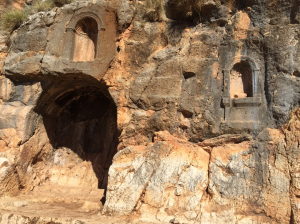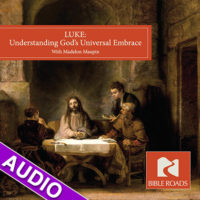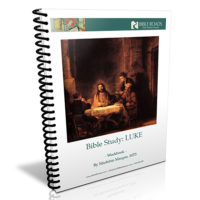One of the more arresting aspects of traveling to Israel, particularly the Galilee area, is how nuances of Jesus’ teachings in the Gospels come to life in wholly unexpected ways.
I had such a moment at Caesarea Philippi. It all began with the familiar passage in Mark 8:27-29:
27 Jesus went on with his disciples to the villages of Caesarea Philippi; and on the way he asked his disciples, “Who do people say that I am?” 28 And they answered him, “John the Baptist; and others, Elijah; and still others, one of the prophets.” 29 He asked them, “But who do you say that I am?” Peter answered him, “You are the Messiah (or Christ)”.
So there we were, entering what is now a major site for Christian pilgrims, north of Capernaum where Jesus lived much of his three-year ministry. What led Jesus to come here and ask this particular question? Our bus had just driven the distance, passing the Golan Heights near Syria as we drove the fifteen miles to the entrance. It wasn’t a simple walk but an all day undertaking, knowing 15 miles was considered a day’s walk in the 1st century. What was it about this place that prompted the Master to ask this question? (The more time spent in Israel, the more these kind of questions directly from the Biblical text come to thought and seem logical to ask!)
The only other reference in the New Testament to Caesarea Philippi is the same story in Matthew, but a different version. With Mark being the first Gospel written, it’s instructive to see if anything gets added to the stories by the time Matthew writes his account some twenty years later. In this case, a vital part was added that answered my question of ‘why this place’.
In Matthew 16:13-19 , the location of Jesus’ question is more specific. “Now when Jesus came into the district of Caesarea Philippi, he asked his disciples, “Who do people say that the Son of Man is?”
Matthew adds to Peter’s brief response (as told in Mark):
…”and the gates of Hades will not prevail against it. 19 I will give you the keys of the kingdom of heaven, and whatever you bind on earth will be bound in heaven, and whatever you loose on earth will be loosed in heaven.”
Imagine the astonishment of discovering that this very place had an enormous cavern that ancients once considered ‘the gates of Hades’. Here human sacrifices occurred in early Canaanite days, when Baal cult worshippers were active and threw their victims down what appeared a bottomless hole. Later when the Greeks took over this area, a temple to the nature god, Pan, was erected, including small niches we saw next to the spring that flowed to a river below.
Clearly, this place had been the site of pagan worship for centuries. Jesus wouldn’t have come on to the actual site, being so associated with pagan worship. But he could easily have been on the hill overlooking it, the one in the near distance, with the object lesson clear to the disciples that any thought of hell – pagan or otherwise – could not challenge the new Kingdom of God that he explained was among them right now.
What struck me was that although Judaism had established monotheism, Jesus pressed his disciples to figure out his identity, not God’s. In that moment I realized monotheism alone wasn’t enough. Mankind needed Christ, the savior and liberator who would, as Malachi prophesied “rise, with healing in its wings” (Mal. 4:2). It was this liberating, spiritual presence that so infused Jesus’ healing ministry that the Master knew his disciples had to understand. Otherwise they would think his healing work was based on personal ability, rather than available for everyone to experience for all time. This healing Christ Jesus so embodied, proved the sovereignty of his Father’s kingdom, the Kingdom of God. This unquenchable power would always triumph over every pagan and political outlier – be it Baal or Rome itself.
Standing in that place, I asked myself if I too truly understood why Jesus’ identity as Christ is so integral to his teachings. I began to glimpse all the ways of modern paganism that Christly love and truth continue to conquer – whether fear of terrorism, disease, poverty or any other calamity. We indeed have a savior. And a trip to Caesarea Philippi helped me glimpse that a little more.





Madelon,
Loved this article/insight – and the one from Jordan. Thank you for sharing.
Shannon
Thank you, Madelon. When I visited the site I did wonder why a pagan site like Caesarea Philippi was the spot where Jesus asked the question regarding his identity. What a wonderful unfolding you had. I appreciate your sharing it.
Thank you for sharing your inspiring epiphany, Madelon! Spot on!
Thanks so much for sharing, very inspiring!!!!!